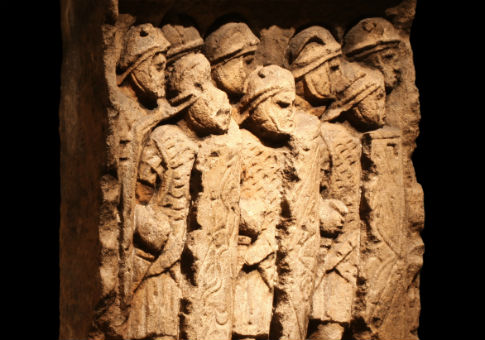In Pax Romana, Adrian Goldsworthy takes us inside the Roman Republic and the Roman Empire to show us how Rome seized territory, held territory, and then kept the peace within its vast borders.
Goldsworthy begins with the Roman army under the republic. From the start, a strong sense of civic purpose gave soldiers the ideological grounding for hard, expansionist battles. Rome's drive was not unusual, but its martial dominance surely was. "There is no doubt that the Republic was an aggressive imperial power, but as soon as we look more closely at contemporary states it becomes obvious that this was equally true of almost every other kingdom, state or people." Throughout Roman history, peace rested more on Rome's potential for massive retribution and its empowerment of regional allies than in vast garrisons stationed in the far reaches of its territory. "Fear, and a sense that Roman rule was usually tolerable even if it was more or less oppressive, may well have convinced most provincials against rebellion."
The Romans were also masters of manipulation. During Julius Caesar's campaign in Gaul, for example, we see how Caesar benefited greatly from disunity among Gaul’s inhabitants. Roman power and success in Gaul and elsewhere rested on its willingness to cede power in return for submission. For Caesar's tribal allies, "conditions were made acceptable to the Gauls, and especially the aristocracy. There continued to be very little interference in the day-to-day affairs of the tribes." And it was not just Caesar. Throughout the centuries, Roman leaders granted generous terms to nobles who submitted to their will. Once the threat of Roman power set in, Rome mostly used local partners to consolidate peaceful stability. This speaks to a broader theme of the book: Rome was not a belligerent cult. Rather, it used military power in a realistic pursuit of greater wealth and prestige.
Not that it always succeeded. Roman governors behaved erratically at different times and places in the empire. The corruption of Gaius Verres in Sicily—who was eloquently convicted at trial by Cicero—was outlier behavior, but at the same time access to Roman public office was defined by corruption. And the arrogance of power sometimes resulted in catastrophe. In Britain, Boudicca’s uprising against Roman rule was fueled by a series of Roman abuses. Boudicca’s daughters were raped, her Celtic tribe's Druid religion was denigrated, and influential Britons were impoverished. In response, Boudicca unified a tribal alliance (but not all the tribes) that slaughtered thousands of Romans, burned their settlements, and nearly expelled the empire. Similar incidents occurred sporadically across the Roman Empire. In each case, organized resistance formed after Rome threatened the survival of existing power structures and cultural traditions. The critical component of Pax Romana was Rome’s ability to empower local power structures in service of its own goals.
Of course, Rome’s military was ultimately the guarantor of its expansion and peace. It was a professional army run by a modern-seeming bureaucracy that accounted for soldiers' service records, the allocation of resources, and the condition of horses. The efficiency of this bureaucracy contributed to the Roman army's power—and, just as importantly, its reputation for power. Well-trained, well-equipped, and determined to pursue victory at any cost, Rome deterred more enemies than it defeated. That was a necessity. The army was deployed strategically due to inevitable resource limitations. When surprised, it could take months —sometimes years—for a concerted imperial response to put down aggression. To mitigate the threat of invasion, Rome established interlocking watch towers and garrisons fixed behind terrain features like rivers. Contrary to the modern understanding of Rome, fixed fortifications such as Hadrian’s Wall in northern England were very rare. Within the empire, Rome played little part in policing its territory, leaving locals to take action against the problem of banditry. Such crime was seen as a low-level threat—something that could be tolerated as long as its impact on commerce and free movement was minimal.
Pax Romana is a highly informative book. It’s also a fun read because it provides an abundance of tragic and sometimes amusing anecdotes along with Goldsworthy's historical analysis. For instance, we hear how "Ptolemaic Egypt developed something close to a formal tour of its sights for visiting Romans, including a trip to the Nile and the opportunity to see the sacred crocodiles being fed. Roman visitors were pampered and entertained but not free to do whatever they liked. When one accidentally killed a cat—an animal considered sacred by ancient tradition—he was lynched by a mob of Alexandrian citizens. Merely being Roman did not make visitors immune from local taboos." Nevertheless, the thesis of the book is serious. Having chartered us through the history of Rome, Goldsworthy argues that the empire's collapse was due to political instability in Rome rather than rot in Roman culture.
Pax Romana is a guide to how the Romans preserved their empire for many centuries. It is a must-read for those interested in history and strategy.
